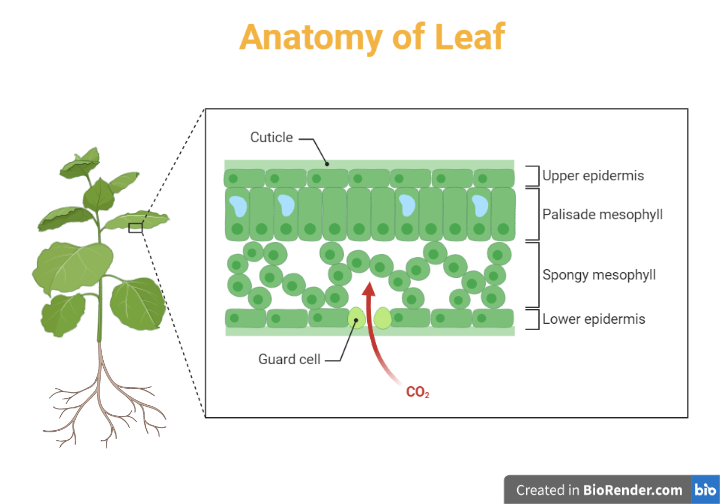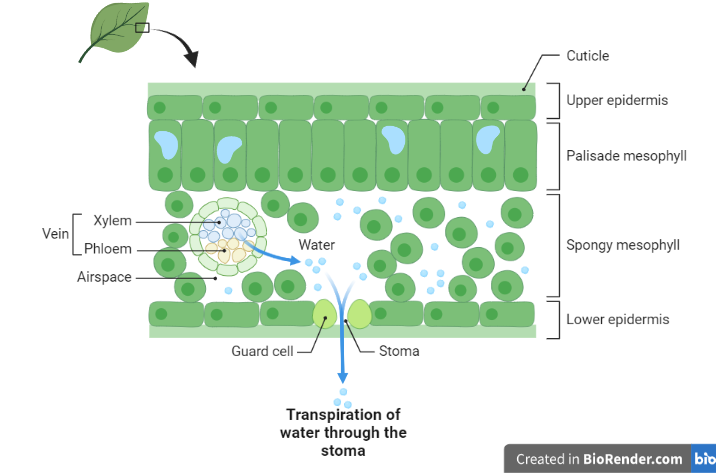Introduction:
The process of the loss of water from the internal tissues of the living plants in the form of vapor the exposed parts of the plants is regarded as transpiration. Plant absorbs large amount of water from the soil through the root hair but only small amount is utilized in different metabolic activities.
Types:
Depending upon the parts of the plant through which the loss of water in the form of vapor take places there are several types of transpiration
Cuticular transpiration
Cuticle is a layer of cutting lying on the surface of the epidermis of leaf and stem. It is generally impervious to water; however, the same amount of water is lost through cuticle and this loos of water through the cuticle in the form of vapor is cuticular transpiration. It constitutes a maximum of 10 % of the total transpiration.
Stomatal transpiration
The process of the loss of water in the from of vapors through the microscopic pores present on the epidermis of the leaf and green stem called stomata is called stomatal transpiration. As most of the transpiration (55-95%) take place through its stomata, it is the most important type of transpiration. Stomata are tiny pores found in the epidermis of leaves and young stems and are surrounded by specialized guard cells called subsidiary cells.

Fig: Anatomy of leaf
Lenticular Transpiration
Loss of water from lenticle (small opening in the corky tissues covering stems) in the form of vapors is called lenticular transpiration. These openings or lenticles have no closing mechanism, so that lenticular transpiration takes place continuously during day as well as night. It is only about 0.5%-1 % of the total transpiration so loss of water through these types of transpiration is insignificant.
Bark Transpiration
Loss of water through the corky covering or bark of the stem is called transpiration. Only very little amount of water is lost through this type of transpiration.
Hydathode Transpiration
Hydathodes are specialized structures found in some plants such as grapevine, sunflower, rose, particularly in the margins of leaves. They can release water droplets through special openings called water pores or water stomata. This process, known as guttation, can result in the loss of water through hydathodes. It is mainly observed in night and rainy season.
Measurement of Transpiration:
Direct Methods
- a. Potometer: A potometer measures water intake by a plant through a cut stem.
- b. Gravimetric Method: Determines water loss by measuring the weight change of a plant or soil.
- c. Heat Balance Method: Calculates the amount of heat energy necessary for water evaporation.
Indirect Methods
- a. Stable Isotope Techniques: Analyzes isotopic composition to estimate transpired water.
- b. Sap Flow Methods: Measures water movement in xylem channels as an indicator of transpiration.
- c. Leaf Porometer: Determines transpiration rate by measuring leaf conductivity.
Mechanism of stomatal movement:
Theory of Photosynthesis in guard cells
Stomata open in the light and close at night, as discovered by Von Mohl (1856). According to him, in the presence of light, chloroplasts found in guard cells photosynthesize, resulting in the formation of carbohydrate (Sugar), which raises osmotic pressure in guard cells. It allows water from neighboring cells to enter and the stomatal aperture to open. In the night, the above process results in stomatal closure.
Starch – Sugar interconversion theory
During day time pH of the cell increases due to consumption of CO2 in photosynthesis. At high pH, enzymes hydrolyze starch and starch water enters into guard cells. They become turgid and causes opening of stomata. Water vapor diffuses at this time and transpiration occurs. During night, the sugar is converted into starch and cell loss water due to which guard cells become flaccid and stomata closed.

Fig: Stomatal Opening and Closing (Starch-Sugar conversion theory)
Active potassium transport ion concept
As the K+ ions are entered into the guard cell, the turgidity of guard cells increased and stomata are opened. When guard cells loss K+ ions the stomata are closed. When K+ ions enter in the guard cells, it forms potassium malate soluble in water and increases osmotic pressure. It causes endosmosis and the guard cells become turgid and stoma opens. However, at night the reverse process occurs and stoma closes.
Factors affecting transpiration:
Environmental Factors
Light: As stomata open in presence in light and close in its absence, light is the most important factor affecting the rate of transpiration through stomatal movements. The amounts of light required to cause stomatal opening differs among the different species of plants. A slight is related to stomatal opening, which in turn is related to the rate of transpiration, light increases the rate of transpiration. Thus, intensity of light is proportional to the rate of transpiration up to certain limit.
Temperature: An increase in temperature causes an increase in stomatal opening. In case of some plants, the stomata don’t open under continuous light when temperature is below is Zero. As temperature is increased then stomatal opening also increases. So that rate of transpiration increases with increase in temperature in such plants.
Humidity: When the relative humidity lowers then the air becomes dry so that the rate of transpiration will be high. Similarly, when the relative humidity is high then the atmosphere around the stomata becomes saturated so that the rate of transpiration will be low. Thus, rate of transpiration is inversely proportional to the relative humidity.
Air movement: When the air is stagnant, then the rate of transpiration is low. But, when the air blows smoothly then air current increases in the rate of transpiration, But that transpiration. But the wind blowing with high velocity decreases the rate or transpiration as it causes the closing of transpiration.
Water deficits and abscisic acid (ABA): When the rate of transpiration exceeds the rate of absorption then a water deficit is developed and results the incipient wilting of leaves and the plant is called water stressed plants. During this condition of water deficit stomatal pores will close, thus reducing the rate of transpiration significantly. When the water potential of such plant is restored then the stomata reopen. It has observed that abscisic acid (ABA) is accumulated in the leaves of water stressed plants. The ABA causes to close the stomata of such plants. However, when the water potential of this water stresses plant is restored, then the stomata reopen and ABA disappears.
Plant Factors
- Leaf Surface Area- Plants with greater leaf surface areas tend to have higher transpiration rates since there is more area available for water loss.
- Leaf Structure- Plants with thinner leaves or more stomata per unit area tend to have higher transpiration rates.
- Stomatal Density and Opening- The number and size of stomata on leaf surfaces might affect transpiration rates. Increased transpiration is often associated with higher stomatal density and bigger stomatal apertures.
- Cuticle Thickness- The thickness of the waxy cuticle layer on leaf surfaces has been shown to influence transpiration rates. Thinner cuticles may permit greater water loss.
- Plant Species- Different plant species have different transpiration rates due to adaptations and physiological properties.
- Hair- Hair form a layer which is insulator so that if decreases the rate of transpiration as it insulates that leaf surface from temperature and air current.
- Arrangement of mesophylls- The rate of transpiration also depends on the arrangement of the mesophyll. If the mesophylls are arranged loosely then rate of transpiration will be high while if they are arranged compactly, then the rate of transpiration will be low.
Significance:
Transpiration is very vital to plants because it supports various important functions. It distributes water and nutrients from the roots to the aerial portions, promoting growth and metabolic activities of the plants. Transpiration also aids in cooling and temperature regulation in plants. It is required for photosynthesis because it provides water for stomatal opening and carbon dioxide exchange. Furthermore, transpiration promotes the circulation of hormones and signaling molecules throughout the plant and helps to support its structural integrity. It can also help to protect against infections and pests. Overall, transpiration is critical for plant survival, development, and physiological function.
Advantages:
- Ascent of sap- The upward movement of water and minerals. i.e., ascent of sap is due to the transpiration pull developed by loss of water or transpiration.
- Cooling effect- Transpiration protects the plant from being overheated by the continuous radiation by evaporating water decreases the temperature.
- Loos of excess of water- It has been seen that plant absorbs excess amount of water than it really needs. So, that this excess water by nay way may be harmful to plant. Transpiration removes this excess of water.
- Quality of fruits- The transpiration increases the concentration of ash and sugar content in fruits. So, it improves quality of fruit.
- It enhances the root growth which supports heavy shoot system.
Disadvantages:
- Loss and misuse of exuded water and energy used in absorption of water.
- It causes wilting of plants and sometime causes death of plants.
- It reduces photosynthesis and metabolic activities.
- It reduces growth of plants
- Water stress dure to transpiration produces abscisic acid (ABA) which promotes abscission of leaves, flower, fruits, etc.
References:
- Díaz-Pérez, J.C., 2019. Transpiration. In Postharvest physiology and biochemistry of fruits and vegetables (pp. 157-173). Woodhead Publishing.
- Pearcy, R.W., Schulze, E.D. and Zimmermann, R., 2000. Measurement of transpiration and leaf conductance. Plant physiological ecology: field methods and instrumentation, pp.137-160.
- de Wit, C.T., 1958. Transpiration and crop yields (No. 64.6).

